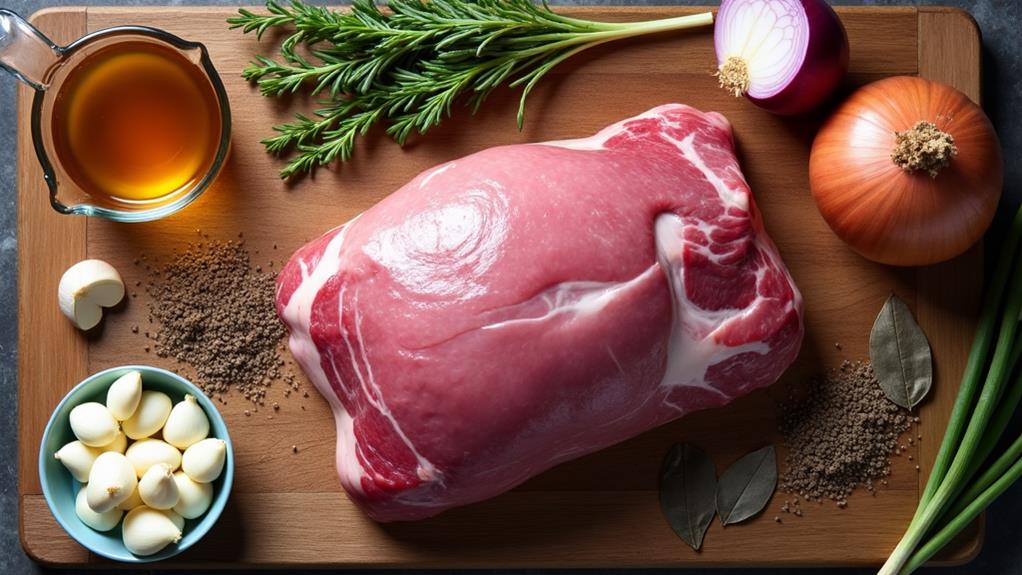You might think braising pork shoulder is too time-consuming, but the reward of tender, flavorful meat makes it worth every minute. This method not only enhances the meat's texture but also allows for rich, complex flavors to develop through slow cooking. As you consider how this dish fits into various culinary traditions, you may find that it offers more than just a satisfying meal; it connects you to a history steeped in comfort and community. There's much more to explore about its origins and the myriad ways it can be prepared.
Key Takeaways
- Braised pork shoulder is a comforting dish known for its melt-in-your-mouth texture, perfect for gatherings or family dinners.
- The slow-cooking method breaks down tough fibers, enhancing flavor and tenderness.
- Key ingredients include pork shoulder, seasoning, olive oil, garlic, onion, and a flavorful braising liquid like stock, beer, or apple cider.
- Cook the pork in a preheated oven at 325°F for 2.5 to 4 hours for optimal results.
- Customize the dish with various herbs and spices, and serve with sides like mashed potatoes or crusty bread.
History
Braised pork shoulder has a rich history rooted in traditional cooking methods across various cultures. You'll find that this dish embodies the art of slow cooking, which tenderizes tougher cuts of meat and brings out incredible flavors.
In Southern U.S. cuisine, braised pork shoulder is a beloved staple, often associated with barbecue and celebratory gatherings. It's hard to imagine a summer cookout without it!
Meanwhile, in European cuisine, countries like Italy and France elevate this dish with local herbs, vegetables, and wines, showcasing regional flavors. The technique of braising dates back to ancient times, where cooks utilized braising liquid to conserve energy while enhancing meat flavors by cooking low and slow.
Now, with the rise of farm-to-table movements, there's a renewed interest in braised pork shoulder. More cooks are embracing heritage cooking by using the whole animal, ensuring nothing goes to waste.
This flavorful cooking method not only connects us to our culinary roots but also invites innovation in the kitchen. So, whether you're channeling Southern charm or European flair, braised pork shoulder is a delicious way to explore the past while enjoying the present!
Recipe

Braised Pork Shoulder Recipe
Braised pork shoulder is a comforting and satisfying dish that's perfect for gatherings or a cozy family dinner. This cooking method breaks down the tough fibers in the meat, resulting in a melt-in-your-mouth texture that's packed with flavor. By combining the rich, savory taste of the pork with a well-seasoned braising liquid, you create a meal that's both hearty and delicious.
To begin, it's essential to select a good quality pork shoulder, which is known for its marbling and connective tissue that contribute to its tenderness when slow-cooked. You can customize the flavor profile by experimenting with different braising liquids, such as beer or apple cider, and adjusting the herbs and spices to your liking. This dish pairs beautifully with sides like mashed potatoes, rice, or crusty bread, perfect for soaking up the flavorful juices.
Ingredients
- 3-4 pounds pork shoulder
- Salt and pepper
- 2 tablespoons olive oil
- 4 cloves garlic, minced
- 1 onion, chopped
- 2 cups chicken stock (or beer/apple cider)
- 2-3 sprigs thyme
- 2-3 bay leaves
Instructions
Start by preheating your oven to 325°F. Season the pork shoulder generously with salt and pepper. In a large, oven-safe skillet or Dutch oven, heat the olive oil over medium-high heat. Once hot, sear the pork shoulder on all sides until golden brown, about 4-5 minutes per side.
Remove the pork and set it aside. In the same skillet, add the chopped onion and garlic, sautéing until softened. Pour in your chosen braising liquid and add the thyme and bay leaves, scraping the bottom of the skillet to release any browned bits.
Return the pork to the skillet, cover, and transfer it to the oven. Braise for 2.5 to 4 hours, or until the meat is tender and easily pulls apart with a fork. Once done, let the pork rest for at least 30 minutes before slicing or shredding for serving.
Extra Tips
For the best results, make sure to sear the pork shoulder adequately to build rich flavors. Additionally, feel free to add vegetables like carrots or potatoes into the braising liquid during the last hour of cooking for a complete meal.
Experimenting with different herbs like rosemary or spices can also enhance the dish's flavor. Don't forget to save the leftover braising liquid; it can be used as a sauce or a base for soups and stews.
Similar dishes include pulled pork, which uses a similar cooking technique, and carnitas, a Mexican dish that can also utilize pork shoulder for flavorful, tender meat. Variations of braised pork can include different spices and regional influences, such as Asian-style braised pork with soy sauce and ginger.
Final Notes
When you take the time to properly braise pork shoulder, you'll discover a dish that not only satisfies your taste buds but also offers versatility for future meals. The key to a perfect braise is that low and slow cooking method, which transforms the pork into tender, juicy goodness.
Remember to season the pork shoulder with salt and pepper before cooking; this simple step enhances the flavor. Don't skip the searing! That caramelization locks in juices and brings out the rich, savory notes from garlic and onions.
Once your braised masterpiece is ready, let it rest for about 30 minutes. This resting period is essential, as it allows the juices to redistribute, ensuring every bite remains moist and flavorful.
The layer of fat on the shoulder adds richness, melting into the meat during cooking for a delightful experience.
And let's not forget about leftovers! You can get creative with them, tossing the braised pork into tacos, sandwiches, or serving it over rice. The possibilities are endless.
